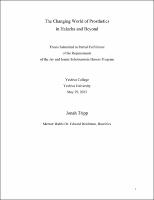Please use this identifier to cite or link to this item:
https://hdl.handle.net/20.500.12202/9492Full metadata record
| DC Field | Value | Language |
|---|---|---|
| dc.contributor.advisor | Reichman, Edward | - |
| dc.contributor.author | Tripp, Jonah | - |
| dc.date.accessioned | 2023-11-16T22:55:57Z | - |
| dc.date.available | 2023-11-16T22:55:57Z | - |
| dc.date.issued | 2023 | - |
| dc.identifier.citation | Tripp, J. (2023). The changing world of prosthetics in halacha and beyond [Undergraduate honors thesis, Yeshiva University]. | en_US |
| dc.identifier.uri | https://hdl.handle.net/20.500.12202/9492 | - |
| dc.description | Undergraduate honors thesis / YU only | en_US |
| dc.description.abstract | __Recently, a Kohen, a Jewish priest, married into my family, which opened up a whole world of Jewish Law within my life that had been previously untouched. Specifically, the concept of a mum, a physical blemish that can disallow a Kohen from performing their holy service, fascinated me as a Pre-med student. What is considered a Mum, and can such a blemish ever be cured to a viable extent? On a separate note, my first cousin had to get his hand amputated only a short while ago due to a freak accident at his work, and is on his way to recovery. Naturally, these two separate conversations lead directly into the world of amputation and prosthesis–its past, present, and future. Furthermore, it is vital to explore the constantly updating realm of technology and its effect on how the concept of mum is seen through the lens of Halacha. The future of prosthetics lies at the heart of medical innovation, and is a vitally important subject to explore through a legal, scientific, and ethical lens. __To address the loss of a limb or amputation, prosthetic devices have been created as corrective measures. Historical records indicate that as early as 2700 BCE, prostheses were utilized. Initially, these prosthetic devices aimed to compensate for the absence of a limb, serving as substitutes and restoring a visually complete appearance for amputees. Gradually, advancements were made to enhance the capabilities and functionality of prosthetic devices. With the emergence of new materials and advancements in modern technology, realistic devices have been developed, offering greater mobility and improved functionality to individuals who have undergone amputations. These artificial limbs not only provide a sense of wholeness but also raise complex questions within Halacha regarding their classification. As technology continues to progress, the intricacies surrounding the categorization of prostheses as genuine limbs become even more intricate. | en_US |
| dc.description.sponsorship | Funded in part by the Jay and Jeanie Schottenstein Honors Program | en_US |
| dc.language.iso | en_US | en_US |
| dc.publisher | Yeshiva University | en_US |
| dc.relation.ispartofseries | Jay and Jeanie Schottenstein Honors Theses;2023 | - |
| dc.rights | Attribution-NonCommercial-NoDerivs 3.0 United States | * |
| dc.rights.uri | http://creativecommons.org/licenses/by-nc-nd/3.0/us/ | * |
| dc.subject | amputation | en_US |
| dc.subject | prothesis | en_US |
| dc.subject | Kohen | en_US |
| dc.subject | Halacha and technology | en_US |
| dc.subject | loss of a limb | en_US |
| dc.subject | artificial limbs | en_US |
| dc.title | The changing world of prosthetics in halacha and beyond | en_US |
| dc.type | Thesis | en_US |
| Appears in Collections: | Jay and Jeanie Schottenstein Honors Student Theses | |
Files in This Item:
| File | Description | Size | Format | |
|---|---|---|---|---|
| Jomah Tripp YU onlyHonors Thesis Prosthetics.pdf | 423.24 kB | Adobe PDF |  View/Open |
This item is licensed under a Creative Commons License

